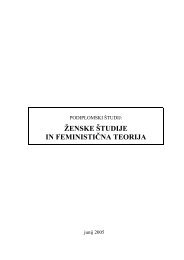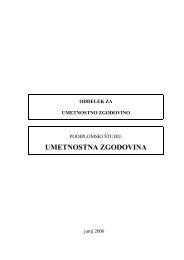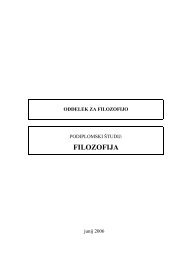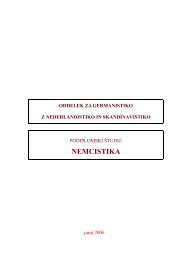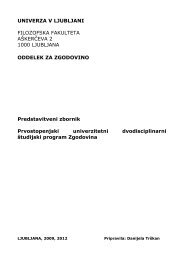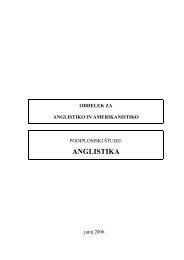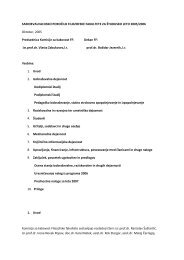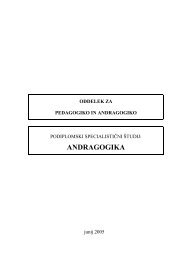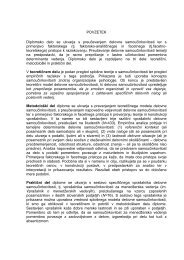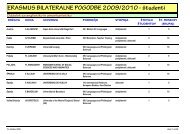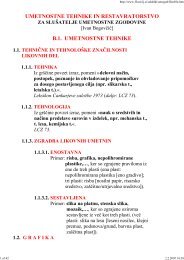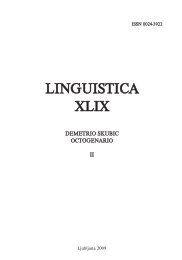B_solo_zgibanke male new_1 - Filozofska fakulteta
B_solo_zgibanke male new_1 - Filozofska fakulteta
B_solo_zgibanke male new_1 - Filozofska fakulteta
Create successful ePaper yourself
Turn your PDF publications into a flip-book with our unique Google optimized e-Paper software.
d. extra-diegetic present-time sphere in the narrator’s total control (italicised<br />
items in the examples).<br />
Combinations of marking styles will indicate that the phrasing supports several<br />
topic-relevant interpretations.<br />
DieGetiC PReSeNt-tiMe SPHeRe iNteRFeReNCeS<br />
the underlying proposition to this discussion is that the default temporal location of<br />
diegetic discourse is within the past-time sphere. the diegetic sections presented as<br />
if situated in the present time-sphere within the default past tense narrative may<br />
range from the paragraph-length to whole chapters in a given fictional text. the<br />
narrator’s option to dislocate the default past-time sphere narrative into the<br />
present-time sphere narrative may be systematic or seemingly random, ie. perhaps<br />
not evident at first reading. examples of seemingly random temporal narrative<br />
dislocation can be found in posmehljivo poželenje (mocking desire) by Jančar. the<br />
present-time interferences of individual paragraphs up to whole chapters increase as<br />
the narrative proceeds. these temporal interferences 1 appear to perform a primarily<br />
textual-stylistic function, creating a dynamic structural texture of the narrative.<br />
the inclusion of present time-sphere narrative sections may be systematic. For<br />
instance, the first and the last chapter in the novel namesto koga roža cveti (instead<br />
of Whom does the Flower Bloom) by Lainšček frame a retrospectively narrated story<br />
which is entirely situated in the past-time sphere, drawing a clear-cut line between<br />
the narration of the main character’s past life and the captivity of his insane mind<br />
in present time.<br />
in the novel pomladni dan (a day in spring) by kosmač the first person-narrator<br />
recalls his life in retrospective flashbacks, where the narrative and story time do not<br />
interfere with each other. Certain sections are narrated in the present time-sphere,<br />
one episode even in the future time-sphere. the translator almost invariably locates<br />
the narrator’s flashback memories in the past time-sphere, simplifying and levelling<br />
out the stylistic structure of the narrative.<br />
extRa-DieGetiC PReSeNt-tiMe SPHeRe OCCURReNCeS<br />
Metalepses are a further type of deliberate stylistic temporal dislocation that can<br />
occur within the past-time sphere narrative. these breaks in narration are<br />
identifiable through the use of the gnomic present tense, the use of the<br />
first-person singular and plural, and through direct addresses to the reader. For<br />
instance, in eliot’s mill on the Floss (mlin na reki Floss), the narrative is<br />
occasionally interrupted by the extra-heterodiegetic narrator to comment<br />
gnomically on the conduct of the characters.<br />
1 although related, this type of temporal interference should not to be treated as an instance of<br />
the historical present tense, but rather as the narrator‘s (or the author’s as may be the case)<br />
decision to use the narrative present tense.<br />
228



